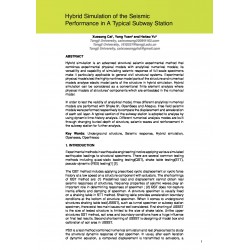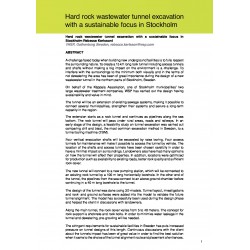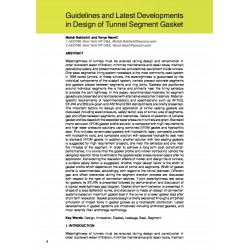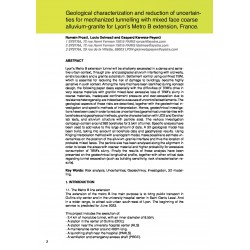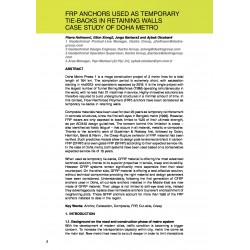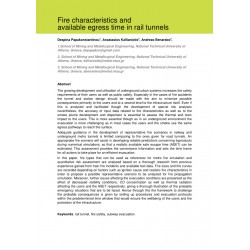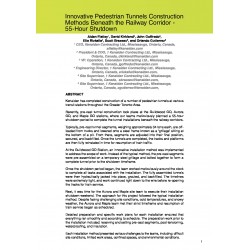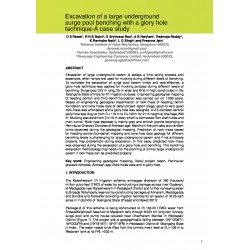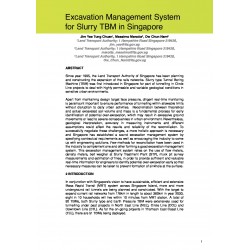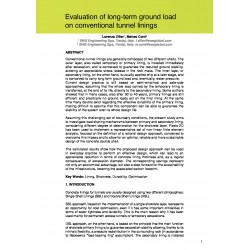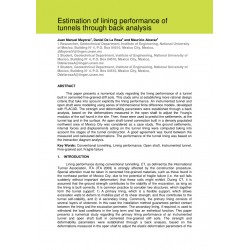No document
Search & filter
Search for a publication
Search & filter
World Tunnelling Congress
WTCThere are 1984 documents.
-
Hybrid Simulation of the Seismic Performance in A Typical Subway Station
Abstract: Hybrid simulation is an advanced structural seismic experimental method that combines experimental physical models with analytical numerical models; its versatility and capability of simulating seismic response of full-scale specimens make it particularly applicable to general civil structural systems. Experimental physical models test the highly nonlinear model parts of the structure and...
0,00 € -
Hard rock wastewater tunnel excavation with a sustainable focus in Stockholm
Abstract: A challenge faced today when building new underground facilities is to fully respect the surrounding nature. To create a 15 km long rock tunnel including access tunnels and shafts without making a big impact on the environment is a challenge. To interfere with the surroundings to the minimum both visually and in the terms of not dewatering the area has been of great importance during the design...
0,00 € -
Guidelines and Latest Developments in Design of Tunnel Segment Gasket
Abstract: Watertightness of tunnels must be ensured during design and construction in order to prevent water infiltration, minimize maintenance and repair costs, maintain operational safety, and protect mechanical and electrical equipment inside tunnels. One-pass segmental lining system nowadays is the most commonly-used system in TBM bored tunnels. In these tunnels, the watertightness is guaranteed by...
0,00 € -
Geological characterization and reduction of uncertain ties for mechanized tunnelling with mixed face coarse...
Abstract: Lyon’s Metro B extension tunnel will be shallowly excavated in a dense and sensitive urban context, through pre- and postglacial alluvium interfacing with old wells, erratic boulders and a granite substratum. Settlement control using confined TBM, which is essential for reducing the risk of damage to buildings, become highly sensitive in such context. Among the risks that have been identified...
0,00 € -
Frp anchors used as temporary tie-backs in retaining walls case study of Doha metro
Abstract: Doha Metro Phase 1 is a mega construction project of 3 metro lines for a total length of 164 km. The completion period is extremely short, with excavation starting in mid2013- and operations expected by 2019. It is the single project with the largest number of Tunnel Boring Machines (TBM) operating simultaneously in the world, with no less than 21 machines in service. Highly-innovative...
0,00 € -
From the Microscope to the Tunnel: State-of-the-art Optimized Production of High Durability Precast Concrete Tunnel...
Abstract: The beginnings of Precast Concrete Tunnel Linings (PCTL) date back to the 1930’s, when it was first used in Great Britain, and many years later in North America (1960’s). In the 1980’s it was already a consolidated technology, boosted by the increasing performance of mechanical excavation by TBM process. The main reason behind this strong development was, of course, the reduction on the costs...
0,00 € -
Fire characteristics and available egress time in rail tunnels
Abstract: The growing development and utilisation of underground urban systems increases the safety requirements of their users as well as public safety. Especially in the cases of fire accidents the tunnel and station design should be made with the aim to minimize possible consequences primarily to the users and at a second level to the infrastructure itself. Even if this is analysed and facilitated...
0,00 € -
Extruded Concrete Lining
Abstract: The most commonly used methods for tunnel construction are the NATM (New Austrian Tunneling Method) and the TBMs (Tunnel Boring Machines). These techniques typically use sprayed concrete and precast segments, respectively.Extruded Concrete Lining (ECL) has recently been used as an innovative alternative to tunnel lining. This technique was developed in the last century by European and Japanese...
0,00 € -
Experimental study to accurate the gasket factor for segmental linings
Abstract: Elastomeric (rubber) gasket is generally used as a water tightening material for segmental linings in shield tunnels. Maximum allowable water pressure of the gasket can be calculated using the principle equation. The gasket factor depends on the profile of the gasket, the dimension of the groove on the segment, compression rate of the gasket and the value of the gap and offset (displacements...
0,00 € -
Innovative Pedestrian Tunnels Construction Methods Beneath the Railway Corridor - 55-Hour Shutdown
Abstract: Kenaidan has completed construction of a number of pedestrian tunnels at various transit stations throughout the Greater Toronto Area. Recently, pre-cast tunnel construction took place at the Guildwood GO, Aurora GO, and Maple GO stations, where our teams meticulously planned a 55-hour shutdown period to complete the tunnel installations beneath the railway corridors.Typically, pre-cast tunnel...
0,00 € -
Experimental Approach to Testing the Vibration on Excavation Machines and Proposal of Some Cuttability Indices
Abstract: In this study, the machine vibration of mechanical excavators were ınvestıgated by means of force responses of conical pick. In this sense, some indices such as the ratio of peak cutting force to mean cutting force (FCp/ FCm), the ratio of peak cutting force to peak normal force (FCp / FNp), the ratio of mean cutting force to mean normal force (FCm / FNm) were analyzed and compared. In...
0,00 € -
Excavation of a large underground surge pool benching with a glory hole technique-A case study
Abstract: Excavation of large underground cavern is always a time taking process and expensive, when ramps are used for mucking during different levels of benching. To complete the excavation of surge pool cavern timely and cost-effective, a glory hole technique was applied for mucking purpose during different levels of benching. Surge pool 375 m long, 25 m wide and 67.6 m high constructed in the...
0,00 € -
Excavation Management System for Slurry TBM in Singapore
Abstract: Since year 1995, the Land Transport Authority of Singapore has been planning and constructing the expansion of the rails networks. Slurry type Tunnel Boring Machine (TBM) was first introduced in Singapore for part of tunnelling in Circle Line projects to deal with highly permeable and variable geological conditions in sensitive urban environments. Apart from maintaining design target face...
0,00 € -
Evaluation of long-term ground load on conventional tunnel linings
Abstract: Conventional tunnel linings are generally composed of two different shells. The outer layer, also called temporary or primary lining, is installed immediately after excavation, and is conceived to guarantee the required ground stability, allowing an appreciable stress release in the rock mass. The inner layer, or secondary lining, on the other hand, is usually applied only at a later stage, and...
0,00 € -
Evaluating the damage of adjacent framed buildings induced by tunnel construction in soil ground
Abstract: Urban tunnel construction may lead damage to the adjacent surface buildings. Empirical method usually oversimplified the surface structure as an equivalent elastic beam which cannot characterize the realistic behaviour of framed building due to frame action. In this study, numerical analyses were carried out to investigate the damage mechanism of fully infilled framed building with opening in...
0,00 € -
Estimation of lining performance of tunnels through back analysis
Abstract: This paper presents a numerical study regarding the lining performance of a tunnel built in cemented fine-grained stiff soils. This study aims at establishing more rational design criteria that take into account explicitly the lining performance. An instrumented tunnel and open shaft were modelling using series of tridimensional finite difference models, developed with FLAC3D. The strength and...
0,00 €

